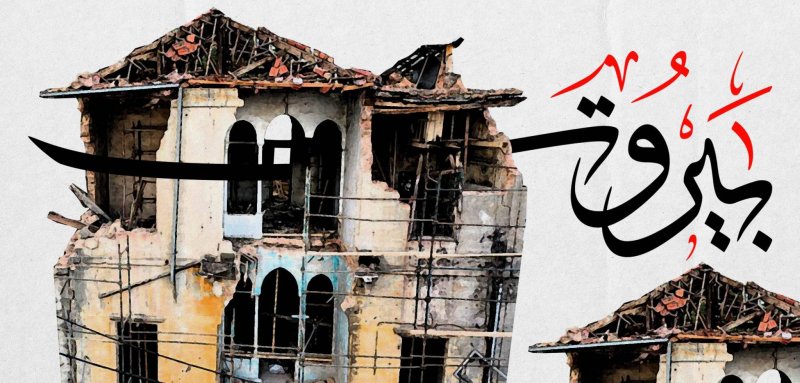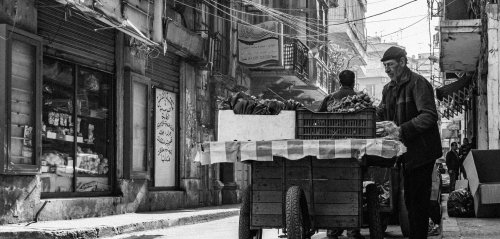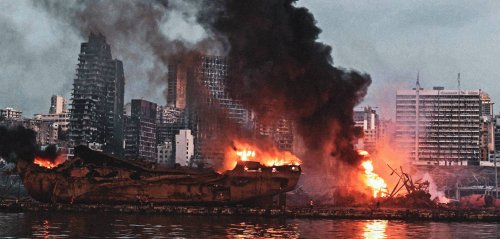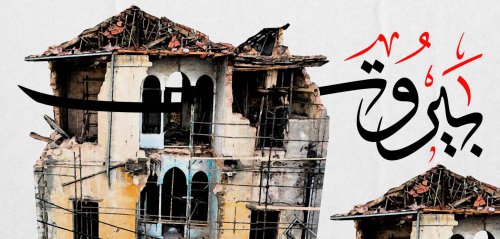This piece is part of Beirut Without Windows, a Raseef22 series, made possible through a grant from QARIB project led by CFI and funded by AFD.
When windows fell out, unveiling the inside of Beirut’s homes, like the beginning of a theatre performance in an absurd play, they all watched: the living rooms, bedrooms, kitchens, and bathrooms were open to the world, inviting the spectator local and foreigner to come in.
When windows fell out, unveiling the inside of Beirut’s homes, like the beginning of a theatre performance in an absurd play, they all watched
Come into our homes, what is left of it. Take a peek through the freshly punctured holes or through the old ones left from the civil war. Watch our photos fly on the sidewalks, and our clothes shrouding the trees. The walls came tumbling down, and what was once a personal space suddenly became exposed and unguarded. The buildings looked like an open dollhouse, only they were sad and ugly, and no kid enjoyed. A dollhouse for the adults to play with, to shuffle around, to stare at, and to exhibit for others. The cameras arrived, and the woman gave a tour around her home. She pointed at this and that, stared at the camera staring back at her, and succumbed to the notion of: “if they do not see, I will be left out.” Damaged doors, damaged windows, damaged pride, but, so long as the world watches, validates, empathizes, like walking in a museum, except there is no brochure.
Of all the house tours taken, I walked none. Enough photos were traveling around to see what they were seeing. The houses in Beirut could not resist the invasion. It was all there; the family photos that used to be hung on the walls, the leftover food, their blankets and pillows. The woman sat on her bed with a book in her hand and reenacted the scene before the camera. This is how she used to live. Winnie-the-Pooh teddy bear is sitting on her wardrobe staring at the wall. Winnie-the Pooh is a little camera-shy. Then, there were all the photos of different faces standing in the middle of the room, either pointing at something that was once there or looking horrified. I entered houses I never set foot in. I saw what they probably did not want me to see. There was a library in one of the photos: It was sophisticated and out of place; an image of the inside of rich people’s homes.
Damaged doors, damaged windows, damaged pride, but, so long as the world watches, validates, empathizes, like walking in a museum, except there is no brochure
After seeing, it becomes necessary not to cherish false hopes no matter how sincere their intention is. When we are shown the destruction of homes, for both poor and rich, we are quick to conclude that everyone is affected in the same way. The same holds true when privileged kids of today’s generation join protestors to “revolt” against the system. Photography feigns solidarity and caters for ideologies that have been dead for a long time. On the one hand, photography invades the privacy of survivors and grants anyone the permission to step in with their dirty shoes. On the other, it records the lives of those who were wounded, displaced, and ignored by their government.
Those who were left with no doors to lock and no windows to shield them had to guard their own homes, staying awake to watch if any “visitors” decide to keep souvenirs. They were naked, stripped of their possessions and left there to fight another war to reclaim their identity. Then, there were the ones who lived in houses with doors and windows but were kept open for others to use their bedrooms, showers, stove, and fridge. They shared privacy and humanity. But the memories continued to circulate before the public, and the reporters kept coming and speaking with the same people. Assess the damage and go. The journalists taped the funerals, the faces as they mourned the loss of their family members so that even those memories were in the public record. The public now took ownership of the intimate details in those houses and was actively suppressing the individuality of each house. They all began to look alike, including the people and how they posed in front of the camera. And, that is how memories are forgotten when the victims no longer offer anything new to the public. The industrialization of memories, sponsored by all the tourists and foreign reporters, robbed the individuals in those houses.
The houses in Beirut could not resist the invasion
Of all the house tours taken, I walked none. There is something unethical about walking in someone’s home and photographing everything. Not only do people represent different social classes but so do their memories. In houses of the bourgeoisie, no bedrooms are shown, and no kitchens or bathrooms. Their privacy remains protected before the public eye; their memories invisible and concealed. And, in times of desperation, only the middle class and the poor yield to the distribution of their personal space.
The woman kneels, picks up the Virgin Mary’s statue, and dusts it off.
FIN
[curtain]
Raseef22 is a not for profit entity. Our focus is on quality journalism. Every contribution to the NasRaseef membership goes directly towards journalism production. We stand independent, not accepting corporate sponsorships, sponsored content or political funding.
Support our mission to keep Raseef22 available to all readers by clicking here!
Interested in writing with us? Check our pitch process here!







